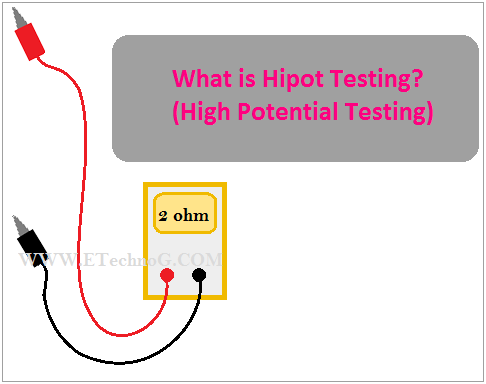What is Hi-Pot or High Pot(High Potential) Testing?
The testing of the dielectric strength of any electrical appliance or machine is known as Hipot Testing. The Hi-Pot testing is also known as high pot or High Potential Testing. In simple words, dielectric strength testing is known as Hipot Testing. It is basically a class of electrical safety of any device or appliance or machine. It is used to test the strength of the insulation of finished appliances before releasing them to the market. The device is to be tested is called Device Under Test(DUT).
The purpose of the Hi-Pot test is to identify any potential weaknesses or flaws in the insulation that may cause electrical leakage or short circuits. By subjecting the device to a higher voltage than its rated operating voltage, the test aims to simulate extreme operating conditions and verify the insulation's ability to withstand such stress.
Generally, a very high voltage is applied to the insulation for this testing. This applied voltage is generally much larger than the operating voltage. For example, if the equipment is designed to operate with 120V or 240V then it will be tested under 1250 to 1500V. Although the applied voltage depends upon the type of insulation of the device. If the device is double insulated then the applied voltage will be very high up to 4000V.
Importance of Hipot Testing
The main function or purpose of Hipot testing is electrical safety. The Hipot testing ensures that the device can be handled safely or not. For example, a household appliance must be tested under the Hipot because during its operation any accident may happen such as electrical shock, or leakage current. It makes sure that the consumer will not get any electric shock when they handle or operate the product.
This testing also ensures that the insulation can withstand the transient voltage. If the device fails during testing the device is again insulated with high-grade material or rejected. The Hipot testing is very helpful to find out the crushed insulation or naked insulation or any cutting in insulation. It helps to resolve the terminal spacing problem, tolerance error in cables, and conductive or contaminated layers around the cable.
How Hipot Testing is Performed?
Hipot testing is performed by connecting one terminal to the ground and another terminal to the equipment. A very high voltage is applied and the flow of current is to be measured. By calculating the current flow the strength of the insulation can be measured. It is obvious that if the insulation is very high the current flow will be very low or negligible but if the insulation is poor the current flow will be high which is not acceptable.
During the testing, it must be ensured that the testing should not be connected to any other contacts. If the device or product can withstand a very high voltage during the testing then it ensures that a large margin of protection exists for the consumer.
During the Hi-Pot test, the leakage current is monitored. Excessive leakage current beyond acceptable limits indicates potential insulation breakdown or flaws. The measured leakage current is compared against predetermined pass/fail criteria. If the leakage current remains within acceptable limits, the device is considered to have passed the Hi-Pot test. Otherwise, further investigation or corrective measures may be required.
It's important to adhere to safety guidelines and follow industry standards and regulations when performing Hi-Pot testing to ensure the safety of personnel and equipment. Testing should be conducted by trained professionals using appropriate safety precautions and equipment.
Types of Hipot Testing
There are both AC and DC Hipot testing are available. In some cases, a combination of AC and DC Hi-Pot testing may be performed to comprehensively assess the insulation integrity of a device or equipment, particularly when it operates on both AC and DC power sources.
AC Hi-Pot testing involves applying an alternating current (AC) voltage higher than the device's rated operating voltage to assess its insulation integrity. The purpose of this test is to determine if the insulation can withstand the specified voltage without breakdown or excessive leakage current. AC Hi-Pot testing is often used for devices or equipment that primarily operate on AC power. Of course, during AC testing other parameters such as frequency are also considered.
Both of the tests are done in the same way but in the case of DC Hipot testing, the applied voltage is more with respect to a factor of 1.414. For example, a 120V or 240V device can be tested with up to 1500V AC Hipot testing whereas it can be tested with up to 2200V DC Hipot Testing. The connection or circuit arrangement is almost the same for both types of testing.
Similar to AC Hi-Pot testing, the voltage is gradually increased to the desired test level and maintained for a specific duration during DC Hi-Pot testing. The leakage current is monitored, and if it remains within acceptable limits, the device is considered to have passed the test. This test is commonly used for devices or equipment that operate on DC power, such as batteries, capacitors, or DC motors.
Read Also:

